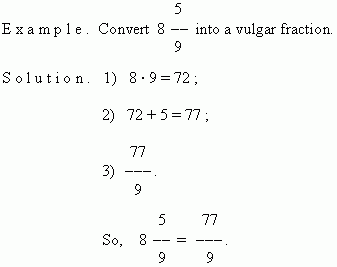Vulgar (simple) fractions
Proper fraction. Improper fraction.
Mixed number (integer and fractional parts).
Converting of a mixed number into a vulgar
improper fraction and back. Reciprocal fractions.
A part of a unit or some equal parts of a unit
is called a
vulgar (simple) fraction
. A number of equal parts into which a
unit has been divided, is called a
denominator
; a number of these taken parts, is called a
numerator
. A fraction record:

Here 3 – a numerator, 7 – a denominator.
If a numerator is less than a denominator, then the fraction is less than 1 and called a
proper
fraction. If a numerator
is equal to a denominator, the fraction is equal to 1. If a numerator is greater than a denominator, the fraction is greater than 1. In both
last cases the fraction is called an
improper
fraction. If a numerator is divisible by a denominator, then this fraction is
equal to a quotient: 63 / 7 = 9. If a division is executed with a remainder, then this improper fraction can be presented as a
mixed number:

Here 9 – an incomplete quotient ( an integer part of the mixed number ), 2 – a remainder ( a numerator of the fractional part ),
7 – a denominator .
It is often necessary to solve a reverse problem – to convert a mixed number into a fraction. For this purpose, multiply
an integer part of a mixed number by a denominator and add a numerator of a fractional part. It will be a numerator of a vulgar
fraction, and its denominator is saved the same.

Reciprocal fractions are two fractions whose product is 1. For example, 3 / 7 and 7 / 3 ; 15 / 1 and 1 / 15 and so on.